哮喘治疗指南-全球哮喘防治创议GINA2012英文版
- 格式:pdf
- 大小:863.72 KB
- 文档页数:32
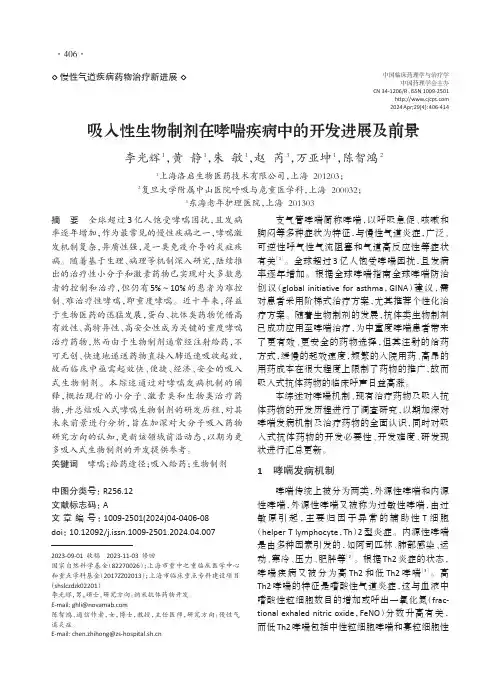
◇慢性气道疾病药物治疗新进展◇摘要全球超过3亿人饱受哮喘困扰,且发病率逐年增加,作为最常见的慢性疾病之一,哮喘激发机制复杂,异质性强,是一类免疫介导的炎症疾病。
随着基于生理、病理等机制深入研究,陆续推出的治疗性小分子和激素药物已实现对大多数患者的控制和治疗,但仍有5%~10%的患者为难控制、难治疗性哮喘,即重度哮喘。
近十年来,得益于生物医药的迅猛发展,蛋白、抗体类药物凭借高有效性、高特异性、高安全性成为关键的重度哮喘治疗药物,然而由于生物制剂通常经注射给药,不可无创、快速地递送药物直接入肺迅速吸收起效,故而临床中亟需起效快、便捷、经济、安全的吸入式生物制剂。
本综述通过对哮喘发病机制的阐释,概括现行的小分子、激素类和生物类治疗药物,并总结吸入式哮喘生物制剂的研发历程,对其未来前景进行分析,旨在加深对大分子吸入药物研究方向的认知,更新该领域前沿动态,以期为更多吸入式生物制剂的开发提供参考。
关键词哮喘;给药途径;吸入给药;生物制剂中图分类号:R256.12文献标志码:A文章编号:1009-2501(2024)04-0406-08doi :10.12092/j.issn.1009-2501.2024.04.007支气管哮喘简称哮喘,以呼吸急促、咳嗽和胸闷等多种症状为特征,与慢性气道炎症,广泛、可逆性呼气性气流阻塞和气道高反应性等症状有关[1]。
全球超过3亿人饱受哮喘困扰,且发病率逐年增加。
根据全球哮喘指南全球哮喘防治创议(global initiative for asthma ,GINA )建议,需对患者采用阶梯式治疗方案,尤其推荐个性化治疗方案。
随着生物制剂的发展,抗体类生物制剂已成功应用至哮喘治疗,为中重度哮喘患者带来了更有效、更安全的药物选择,但其注射的给药方式,缓慢的起效速度,频繁的入院用药、高昂的用药成本在很大程度上限制了药物的推广,故而吸入式抗体药物的临床呼声日益高涨。
本综述对哮喘机制、现有治疗药物及吸入抗体药物的开发历程进行了调查研究,以期加深对哮喘发病机制及治疗药物的全面认识,同时对吸入式抗体药物的开发必要性、开发难度、研发现状进行汇总更新。

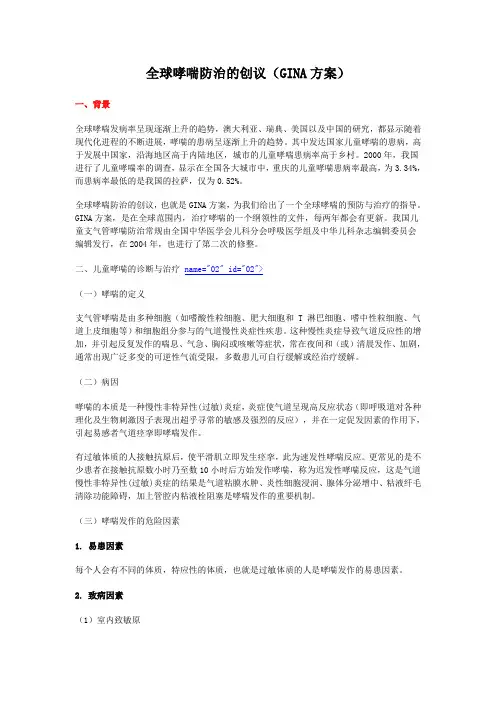
全球哮喘防治的创议(GINA方案)一、背景全球哮喘发病率呈现逐渐上升的趋势,澳大利亚、瑞典、美国以及中国的研究,都显示随着现代化进程的不断进展,哮喘的患病呈逐渐上升的趋势。
其中发达国家儿童哮喘的患病,高于发展中国家,沿海地区高于内陆地区,城市的儿童哮喘患病率高于乡村。
2000年,我国进行了儿童哮喘率的调查,显示在全国各大城市中,重庆的儿童哮喘患病率最高,为3.34%,而患病率最低的是我国的拉萨,仅为0.52%。
全球哮喘防治的创议,也就是GINA方案,为我们给出了一个全球哮喘的预防与治疗的指导。
GINA方案,是在全球范围内,治疗哮喘的一个纲领性的文件,每两年都会有更新。
我国儿童支气管哮喘防治常规由全国中华医学会儿科分会呼吸医学组及中华儿科杂志编辑委员会编辑发行,在2004年,也进行了第二次的修整。
二、儿童哮喘的诊断与治疗name="02" id="02">(一)哮喘的定义支气管哮喘是由多种细胞(如嗜酸性粒细胞、肥大细胞和 T 淋巴细胞、嗜中性粒细胞、气道上皮细胞等)和细胞组分参与的气道慢性炎症性疾患。
这种慢性炎症导致气道反应性的增加,并引起反复发作的喘息、气急、胸闷或咳嗽等症状,常在夜间和(或)清晨发作、加剧,通常出现广泛多变的可逆性气流受限,多数患儿可自行缓解或经治疗缓解。
(二)病因哮喘的本质是一种慢性非特异性(过敏)炎症,炎症使气道呈现高反应状态(即呼吸道对各种理化及生物刺激因子表现出超乎寻常的敏感及强烈的反应),并在一定促发因素的作用下,引起易感者气道痉挛即哮喘发作。
有过敏体质的人接触抗原后,使平滑肌立即发生痉挛,此为速发性哮喘反应。
更常见的是不少患者在接触抗原数小时乃至数10小时后方始发作哮喘,称为迟发性哮喘反应,这是气道慢性非特异性(过敏)炎症的结果是气道粘膜水肿、炎性细胞浸润、腺体分泌增中、粘液纤毛清除功能障碍,加上管腔内粘液栓阻塞是哮喘发作的重要机制。

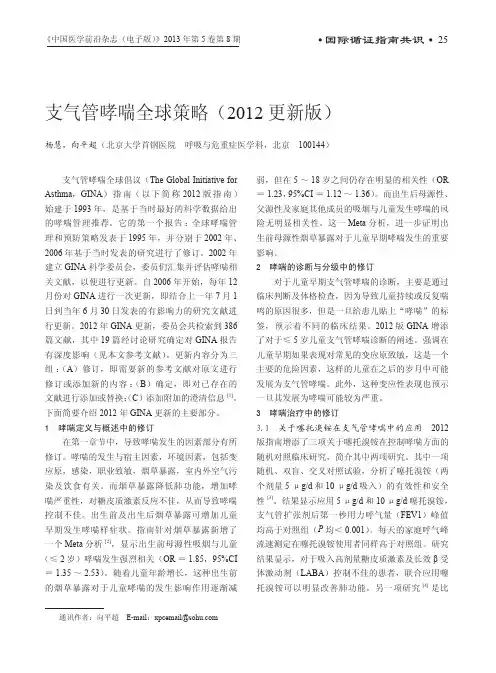
《中国医学前沿杂志(电子版)》2013年第5卷第8期25● 国际循证指南共识 ●支气管哮喘全球策略(2012更新版)杨慧,向平超 (北京大学首钢医院 呼吸与危重症医学科,北京 100144)通讯作者:向平超 E-mail :xpcemail@支气管哮喘全球倡议(The Global Initiative for Asthma ,GINA )指南(以下简称2012版指南)始建于1993年,是基于当时最好的科学数据给出的哮喘管理推荐。
它的第一个报告:全球哮喘管理和预防策略发表于1995年,并分别于2002年、2006年基于当时发表的研究进行了修订。
2002年建立GINA 科学委员会,委员们汇集并评估哮喘相关文献,以便进行更新。
自2006年开始,每年12月份对GINA 进行一次更新,即结合上一年7月1日到当年6月30日发表的有影响力的研究文献进行更新。
2012年GINA 更新,委员会共检索到386篇文献,其中19篇经讨论研究确定对GINA 报告有深度影响(见本文参考文献)。
更新内容分为三组:(A )修订,即需要新的参考文献对原文进行修订或添加新的内容;(B )确定,即对已存在的文献进行添加或替换;(C )添加附加的澄清信息[1]。
下面简要介绍2012年GINA 更新的主要部分。
1 哮喘定义与概述中的修订在第一章节中,导致哮喘发生的因素部分有所修订。
哮喘的发生与宿主因素,环境因素,包括变应原,感染,职业致敏,烟草暴露,室内外空气污染及饮食有关。
而烟草暴露降低肺功能,增加哮喘严重性,对糖皮质激素反应不佳,从而导致哮喘控制不佳。
出生前及出生后烟草暴露可增加儿童早期发生哮喘样症状。
指南针对烟草暴露新增了一个Meta 分析[2],显示出生前母源性吸烟与儿童(≤2岁)哮喘发生强烈相关(OR =1.85,95%CI =1.35~2.53)。
随着儿童年龄增长,这种出生前的烟草暴露对于儿童哮喘的发生影响作用逐渐减弱,但在5~18岁之间仍存在明显的相关性(OR =1.23,95%CI =1.12~1.36)。

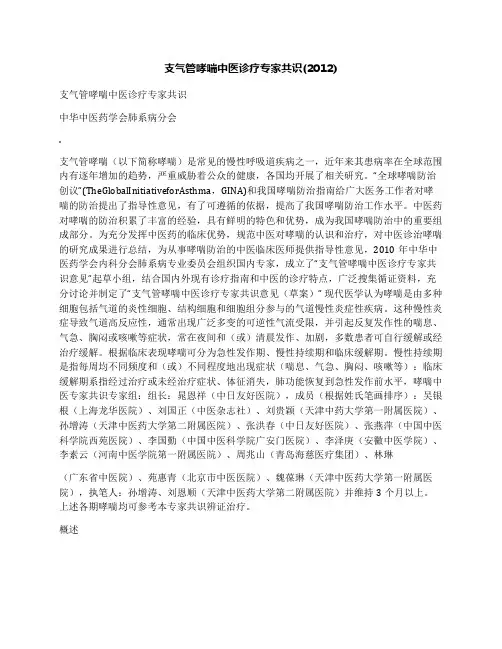
支气管哮喘中医诊疗专家共识(2012)支气管哮喘中医诊疗专家共识中华中医药学会肺系病分会.支气管哮喘(以下简称哮喘)是常见的慢性呼吸道疾病之一,近年来其患病率在全球范围内有逐年增加的趋势,严重威胁着公众的健康,各国均开展了相关研究。
“全球哮喘防治创议”(TheGlobalInitiativeforAsthma,GINA)和我国哮喘防治指南给广大医务工作者对哮喘的防治提出了指导性意见,有了可遵循的依据,提高了我国哮喘防治工作水平。
中医药对哮喘的防治积累了丰富的经验,具有鲜明的特色和优势,成为我国哮喘防治中的重要组成部分。
为充分发挥中医药的临床优势,规范中医对哮喘的认识和治疗,对中医诊治哮喘的研究成果进行总结,为从事哮喘防治的中医临床医师提供指导性意见,2010年中华中医药学会内科分会肺系病专业委员会组织国内专家,成立了“支气管哮喘中医诊疗专家共识意见”起草小组,结合国内外现有诊疗指南和中医的诊疗特点,广泛搜集循证资料,充分讨论并制定了“支气管哮喘中医诊疗专家共识意见(草案)” 现代医学认为哮喘是由多种细胞包括气道的炎性细胞、结构细胞和细胞组分参与的气道慢性炎症性疾病。
这种慢性炎症导致气道高反应性,通常出现广泛多变的可逆性气流受限,并引起反复发作性的喘息、气急、胸闷或咳嗽等症状,常在夜间和(或)清晨发作、加剧,多数患者可自行缓解或经治疗缓解。
根据临床表现哮喘可分为急性发作期、慢性持续期和临床缓解期。
慢性持续期是指每周均不同频度和(或)不同程度地出现症状(喘息、气急、胸闷、咳嗽等):临床缓解期系指经过治疗或未经治疗症状、体征消失,肺功能恢复到急性发作前水平,哮喘中医专家共识专家组:组长:晁恩祥(中日友好医院),成员(根据姓氏笔画排序):吴银根(上海龙华医院)、刘国正(中医杂志社)、刘贵颖(天津中药大学第一附属医院)、孙增涛(天津中医药大学第二附属医院)、张洪春(中日友好医院)、张燕萍(中国中医科学院西苑医院)、李国勤(中国中医科学院广安门医院)、李泽庚(安黴中医学院)、李素云(河南中医学院第一附属医院)、周兆山(青岛海慈医疗集团)、林琳(广东省中医院)、苑惠青(北京市中医医院)、魏葆琳(天津中医药大学第一附属医院),执笔人:孙增涛、刘恩顺(天津中医药大学第二附属医院)并维持3个月以上。
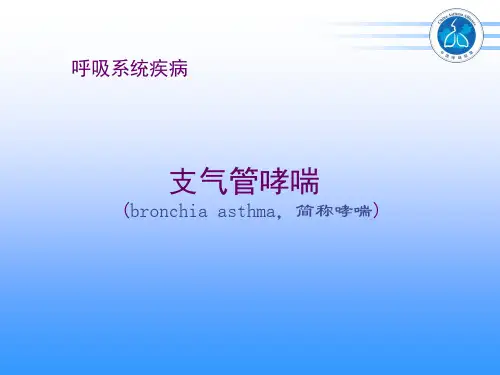
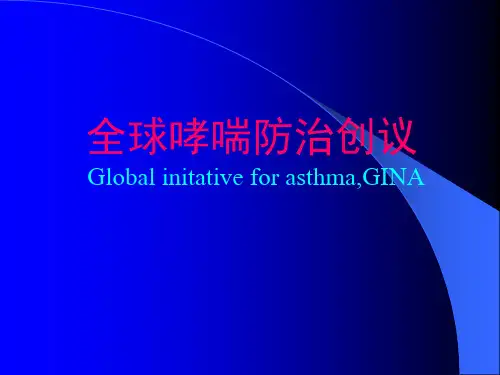

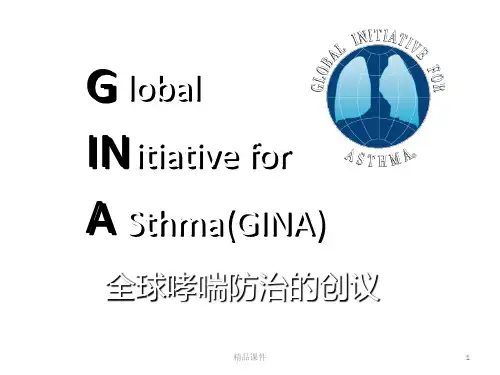
POCKET GUIDE FOR ASTHMA MANAGEMENT AND PREVENTION(for Adults and Children Older than 5 Y earsR R E P RO D UC EOP Y R I G H T ED M A T ER I A L - D O N O T A L T E R OR R E P RO D UCGLOBAL INITIATIVEFOR ASTHMABoard of Directors (2012)Mark FitzGerald, M.D., Canada, Chair Eric D. Bateman, M.D., South Africa Louis-Philippe Boulet, M.D., Canada Alvaro Cruz, M.D., Brazil Tari Haahtela, M.D., Finland Mark Levy, M.D., United KingdomPaul O’Byrne, M.D., Canada Ken Ohta, M.D., JapanPierluigi Paggario, M.D., ItalySoren Pedersen, M.D., Denmark Manuel Soto-Quiroz, M.D., Costa Rica Gary W ong, M.D., Hong Kong ROCGINA Assembly (2012)Louis-Philippe Boulet, MD, Canada, Chair GINA Assembly members from 45 countries (names are listed on website: )OP YR I G H T ED M A T ER IA L- DO N OT AL TE R OR R E P RO D UCTABLE OF CONTENTSPREFACE3WHAT IS KNOWN ABOUT ASTHMA?5DIAGNOSING ASTHMA7 Figure 1. Is it Asthma? 7CLASSIFICATION OF ASTHMA BY LEVEL OF CONTROL 9Figure 2. L evels of Asthma Control 9FOUR COMPONENTS OF ASTHMA CARE10Component 1. Develop Patient/Doctor Partnership 10Figure 3. Example of Contents of an Action Plan to MaintainAsthma Control11Component 2. Identify and Reduce Exposure to Risk Factors 12 Figure 4. Strategies for Avoiding Common Allergens andPollutants12Component 3. Assess, Treat, and Monitor Asthma 13 Figure 5.Management Approach Based on Control 15 Figure 6. Estimated Equipotent Doses of InhaledGlucocorticosteroids 16Figure 7. Questions for Monitoring Asthma care18Component 4. Manage Exacerbations 19Figure 8. S everity of Asthma Exacerbations22SPECIAL CONSIDERATIONS IN MANAGING ASTHMA23Appendix A: Glossary of Asthma Medications - Controllers24Appendix B: Combination Medications for Asthma 25Appendix C: Glossary of Asthma Medications - Relievers26OP Y R I G H T EDM A T ER IA L- DON OT L TE ROR R E P RO D UC EPREFACEAsthma is a major cause of chronic morbidity and mortality throughout the world and there is evidence that its prevalence has increased considerably over the past 20 years, especially in children. The Global Initiative for Asthma was created to increase awareness of asthma among health professionals, public health authorities, and the general public, and to improve prevention and management through a concerted worldwide effort. The Initiative prepares scientific reports on asthma, encourages dissemination and implementation of the recommendations, and promotes international collaboration on asthma research.The Global Initiative for Asthma offers a framework to achieve and maintain asthma control for most patients that can be adapted to local health care systems and resources. Educational tools, such as laminated cards, or computer-based learning programs can be prepared that are tailored to these systems and resources.The Global Initiative for Asthma program publications include:• Global Strategy for Asthma Management and Prevention (2012).Scientific information and recommendations for asthma programs. • Global Strategy for Asthma Management and Prevention GINA Executive Summary. Eur Respir J 2008; 31: 1-36• Pocket Guide for Asthma Management and Prevention for Adultsand Children Older Than 5 Years (2012). Summary of patient care information for primary health care professionals.• Pocket Guide for Asthma Management and Prevention in Children 5Years and Younger (2009). Summary of patient care information for pediatricians and other health care professionals.• What You and Your Family Can Do About Asthma. An informationbooklet for patients and their families.Publications are available from .This Pocket Guide has been developed from the Global Strategy for Asthma Management and Preventi on (Updated 2012). Technical discussions of asthma, evidence levels, and specific citations from the scientific literature are included in that source document.OP Y R I G H T ED M A T ER IA L- DO N OT AL TE R OR R E P RO D UC EAcknowledgements:Grateful acknowledgement is given for unrestricted educational grants from Almirall, AstraZeneca, Boehringer Ingelheim, Chiesi Group, CIPLA, GlaxoSmithKline, Merck Sharp & Dohme, Novartis, Quintiles and Takeda. The generous contributions of these companies assured that the GINA Committees could meet together and publications could be printed for wide distribution. H owever, the GINA Committee participants are solely responsible for the statements and conclusions in the publications.OP Y R I G H T ED M A T ER IA L- DO N OT AL TE R OR R E P RO D UC EWHAT IS KNOWN ABOUT ASTHMA?Unfortunately …asthma is one of the most common chronic diseases, with an estimated 300 million individuals affected worldwide. Its prevalence is increasing, especially among children.Fortunatel y…asthma can be effectively treated and most patients can achieve good control of their disease. When asthma is under control patients can:√Avoid troublesome symptoms night and day √Use little or no reliever medication√Have productive, physically active lives √Have (near) normal lung function √Avoid serious attacks• Asthma causes recurring episodes of wheezing, breathlessness, chesttightness , and coughing , particularly at night or in the early morning. • Asthma is a chronic inflammatory disorder of the airways. Chronicallyinflamed airways are hyperresponsive ; they become obstructed and airflow is limited (by bronchoconstriction, mucus plugs, and increased inflammation) when airways are exposed to various risk factors.• Common risk factors for asthma symptoms include exposure to allergens(such as those from house dust mites, animals with fur, cockroaches, pollens, and molds), occupational irritants, tobacco smoke, respiratory (viral) infections, exercise, strong emotional expressions, chemical irritants, and drugs (such as aspirin and beta blockers).• A stepwise approach to pharmacologic treatment to achieve andmaintain control of asthma should take into account the safety of treatment, potential for adverse effects, and the cost of treatment required to achieve control.• Asthma attacks (or exacerbations) are episodic, but airway inflammationis chronically present.OP Y R I G H T ED M A T ER IA L- DO N OT AL TE R OR R E P RO D UC E• For many patients, controlle r medication must be taken daily to preventsymptoms, improve lung function, and prevent attacks. Reliever medications may occasionally be required to treat acute symptoms such as wheezing, chest tightness, and cough.• To reach and maintain asthma control requires the development of apartnership between the person with asthma and his or her health care team.• Asthma is not a cause for shame. Olympic athletes, famous leaders,other celebrities, and ordinary people live successful lives with asthma.OP Y R I G H T ED M A T ER IA L- DO N OT AL TE R OR R E P RO D UC EDIAGNOSING ASTHMAAsthma can often be diagnosed on the basis of a patient’s symptoms and medical history (Figure 1).Measurements of lung function provide an assessment of the severity, repairability, and variability of airflow limitation, and help confirm the diagnosis of asthma.Spirometry is the preferred method of measuring airflow limitation and its reversibility to establish a diagnosis of asthma.• An increase in FEV 1 of ≥ 12% and ≥ 200 ml after administrationof a bronchodilator indicates reversible airflow limitation consistent Presence of any of these signs and symptoms should increase the suspicion of asthma:Wheezing high-pitched whistling sounds when breathing out—especially in children. (A normal chest examination does not exclude asthma.) History of any of the following:• Cough, worse particularly at night • Recurrent wheeze• Recurrent difficult breathing • Recurrent chest tightnessSymptoms occur or worsen at night, awakening the patient. Symptoms occur or worsen in a seasonal pattern.The patient also has eczema, hay fever, or a family history of asthma or atopic diseases.Symptoms occur or worsen in the presence of:• Animals with fur • Aerosol chemicals• Changes in temperature • Domestic dust mites• Drugs (aspirin, beta blockers)• Exercise • Pollen• Respiratory (viral) infections • Smoke• Strong emotional expressionSymptoms respond to anti-asthma therapyPatients colds "go to the chest" or take more than 10 days to clear upFigure 1. Is it Asthma?OP Y R I G H T ED M A T ER IA L- DO N OT AL TE R OR R E P RO D UC EPeak expiratory flow (PEF) measurements can be an important aid in both diagnosis and monitoring of asthma.• PEF measurements are ideally compared to the patient’s own previousbest measurements using his/her own peak flow meter.• An improvement of 60 L/min (or≥ 20% of the pre-bronchodilator PEF)after inhalation of a bronchodilator, or diurnal variation in PEF of more than 20% (with twice-daily readings, more than 10%), suggests a diagnosis of asthma.Additional diagnostic tests:• For patients with symptoms consistent with asthma, but normal lungfunction, measurements of airway responsiveness to methacholine and histamine, an indirect challenge test such as inhaled mannitol, or exercise challenge may help establish a diagnosis of asthma.• Skin tests with allergens or measurement of specific IgE in serum:The presence of allergies increases the probability of a diagnosis of asthma, and can help to identify risk factors that cause asthma symptoms in individual patients.Diagnostic ChallengesCough-variant asthma. Some patients with asthma have chronic cough(frequently occurring at night) as their principal, if not only, symptom. For these patients, documentation of lung function variability and airway hyperresponsiveness are particularly important.Exercise-induced bronchoconstriction. Physical activity is an importantcause of asthma symptoms for most asthma patients, and for some (including many children) it is the only cause. Exercise testing with an 8-minute running protocol can establish a firm diagnosis of asthma. Children 5 Years and Younger . Not all young children who wheezehave asthma. In this age group, the diagnosis of asthma must be based largely on clinical judgment, and should be periodically reviewed as the child grows (see the GINA Pocket Guide for Asthma Management and Prevention in Children 5 Years and Younger for further details). Asthma in the elderly. Diagnosis and treatment of asthma in the elderlyare complicated by several factors, including poor perception of symptoms, acceptance of dyspnea as being “normal” for old age, and reduced expectations of mobility and activity. Distinguishing asthma from COPD is particularly difficult, and may require a trial of treatment. Occupational asthma. Asthma acquired in the workplace is adiagnosis that is frequently missed. The diagnosis requires a defined history of occupational exposure to sensitizing agents; an absence of asthma symptoms before beginning employment; and a documented relation¬ship between symptoms and the workplace (improvement in symptoms away from work and worsening of symptoms upon returning to work). OP Y R I G H T ED M A T ER IA L- DO N OT AL TE R OR R E P RO D UC ECLASSIFICATION OF ASTHMA BY LEVEL OF CONTROLThe goal of asthma care is to achieve and maintain control of the clinical manifestations of the disease for prolonged periods. When asthma is controlled, patients can prevent most attacks, avoid troublesome symptoms day and night, and keep physically active.The assessment of asthma control should include control of the clinical manifestations and control of the expected future risk to the patient such as exacerbations, accelerated decline in lung function, and side-effects of treatment. In general, the achievement of good clinical control of asthma leads to reduced risk of exacerbations.Figure 2 describes the clinical characteristics of controlled, partly controlled, and uncontrolled asthma.Examples of validated measures for assessing clinical control of asthma include:• Asthma Control Test (ACT): • Childhood Asthma Control test (C-Act)• Asthma Control Questionnaire (ACQ): /Asthma1.htm Figure 2. Levels of Asthma ControlA. Assessment of current clinical control (preferably over 4 weeks)Characteristics Controlled(All of the following)Partly Controlled(Any measure presented)UncontrolledDaytime symptoms None (twice or less/week)More than twice/weekThree or more features of partly controlled asthma*†Limitation of activities None Any Nocturnalsymptoms/awaking NoneAnyNeed for reliever/rescue inhalerNone (twice or less/week)More than twice/week Lung function (PEF or FEV 1)‡Normal< 80% predicted or personal best (if known)B. Assessment of Future Risk (risk of exacerbations, instability, rapid decline in lung function, side effects)Features that are associated with increased risk of adverse events in the future include:Poor clinical control, frequent exacerbations in past year*, ever admission to critical care for asthma, low FEV 1, exposure to cigarette smoke, high dose medications* Any exacerbation should prompt review of maintenance treatment to ensure that it is adequate † By definition, an exacerbation in any week makes that an uncontrolled asthma week ‡ Without administration of bronchodilatorLung function is not a reliable test for children 5 years and younger.OP Y R I G H T ED M A T ER IA L- DO N OT AL TE R OR R E P RO D UC EFOUR COMPONENTS OF ASTHMA CAREFour interrelated components of therapy are required to achieve and maintain control of asthma:Component 1. Develop patient/doctor partnershipComponent 2. Identify and reduce exposure to risk factors Component 3. Assess, treat, and monitor asthma Component 4. Manage asthma exacerbationsComponent 1: Develop Patient/Doctor PartnershipThe effective management of asthma requires the development of a partnership between the person with asthma and his or her health care team.With your help, and the help of others on the health care team, patients can learn to:• Avoid risk factors• Take medications correctly• Understand the difference between "controller" and "reliever" medications • Monitor their status using symptoms and, if relevant, PEF • Recognize signs that asthma is worsening and take action • Seek medical advice as appropriateEducation should be an integral part of all interactions between health care professionals and patients. Using a variety of methods—such as discussions (with a physician, nurse, outreach worker, counselor, or educator), demonstrations, written materials, group classes, video or audio tapes, dramas, and patient support groups—helps reinforce educational messages.Working together, you and your patient should prepare a written personal asthma action plan that is medically appropriate and practical. A sample asthma plan is shown in Figure 3.Additional written asthma action plans can be found on several websites, including:/asthma/index.html OP Y R I G H T ED M A T ER IA L- DO N OT AL TE R OR R E P RO D UC EFigure 3. Example of Contents of a Written Asthma to Maintain Asthma ControlYour Regular Treatment:1.Each day take__________________________2.Before exercise, take___________________WHEN TO INCREASE TREATMENT Assess your level of Asthma Control In the past week have you had:Daytime asthma symptoms more than 2 times? No Yes Activity or exercise limited by asthma? No Yes Walking at night because of asthma? No Yes The need to use your (rescue medication) more than 2 times? No Yes If you are monitoring peak flow, peak flow less than______? No Yes If you answered YES to three or more of these questions, your asthma is uncontrolled and you may need to step up your treatment.HOW TO INCREASE TREATMENTSTEP UP your treatment as follows and assess improvement every day:_________________________________[Write in next treatment step here]Maintain this treatment for_______________________days [specify number]WHEN TO CALL THE DOCTOR/CLINIC.Call your doctor/clinic: ________________________ [provide phone numbers]If you don't respond in ________________ days [specify number]___________________________________ [optional lines for additional instruction]EMERGENCY/SEVERE LOSS OF CONTROL√If you have severe shortness of breath, and can only speak in short sentences, √If you having a severe attack of asthma and are frightened,√If you need your reliever medication more than every 4 hours and are notimproving.1. Take 2 to 4 puffs ___________________ [reliever medication].2. Use ______ mg of __________________________(oral glucocorticosteriod).3. Seek medical help: Go to _____________________________________________Address:________________________Phone: __________________________4.Continue to use your __________________________________[reliever medication] until your are able to get medical help.OP Y R I G H T ED M A T ER IA L- DO N OT AL TE R OR R E P RO D UC EComponent 2: Identify and Reduce Exposure to Risk FactorsTo improve control of asthma and reduce medication needs, patients should take steps to avoid the risk factors that cause their asthma symptoms (Figure 4). However, many asthma patients react to multiple factors that are ubiquitous in the environment, and avoiding some of these factors completely is nearly impossible. Thus, medications to maintain asthma control have an important role because patients are often less sensitive to these risk factors when their asthma is under control.Physical activity is a common cause of asthma symptoms but patients should not avoid exercise. Symptoms can be prevented by taking a rapid-acting inhaled β2-agonist before strenuous exercise (a leukotriene modifier or cromone are alternatives).Patients with moderate to severe asthma should be advised to receive an influenza vaccination every year, or at least when vaccination of the general population is advised. Inactivated influenza vaccines are safe for adults and children over age 3.Avoidance measures that improve control of asthma and reduce medication needs:• Tobacco smoke: Stay away from tobacco smoke. Patients and parents should not smoke.• Drugs, foods, and additives: Avoid if they are known to case symptoms.• Occupational sensitizers: Reduce or, preferably, avoid exposure to these agentsReasonable avoidance measures that can be recommended but have not been shown to have clinical benefit• House dust mites: Wash bed linens and blankets weekly in hot water and dry in a hotdryer or sun. Encase pillows and mattresses in air-tight covers. Replace carpets with hard flooring, especially in sleeping rooms. (If possible, use vacuum cleaner with filters. Use acaricides or tannic acid to kill mites--but make sure the patient is not at home when the treatment occurs.• Animals with fur: Use air filters. (Remove animals from the home, or at least from thesleeping area. Wash the pet.)• Cockroaches: Clean home thoroughly and often. Use pesticide spray--but make surethe patient is not at home when spraying occurs.• Outdoor pollens and mold: Close windows and doors and remain indoors whenpollen and mold counts are highest.• Indoor mold: Reduce dampness in the home; clean any damp areas frequentlyFigure 4. Strategies for Avoiding Common Allergens and Pollutants OP Y R I G H T ED M A T ER IA L- DO N OT AL TE R OR R E P RO D UC EComponent 3: Assess, Treat and Monitor AsthmaThe goal of asthma treatment—to achieve and maintain clinical control— can be reached in most patients through a continuous cycle that involves• Assessing Asthma Control • Treating to Achieve Control • Monitoring to Maintain ControlAssessing Asthma ControlEach patient should be assessed to establish his or her current treatment regimen, adherence to the current regimen, and level of asthma control. A simplified scheme for recognizing controlled, partly controlled, and uncontrolled asthma is provided in Figure 2.Treating to Achieve ControlEach patient is assigned to one of five treatment “steps.” Figure 5 details the treatments at each step for adults and children age 5 and over.At each treatment step, reliever medication should be provided for quick relief of symptoms as needed. (However, be aware of how much reliever medication the patient is using—regular or increased use indicates that asthma is not well controlled.)At Steps 2 through 5, patients also require one or more regular c ontroller medications , which keep symptoms and attacks from starting. Inhaled glucocorticosteroids (Figure 6) are the most effective controller medications currently available.For most patients newly diagnosed with asthma or not yet on medication, treatment should be started at Step 2 (or if the patient is very symptomatic, at Step 3). If asthma is not controlled on the current treatment regimen, treatment should be stepped up until control is achieved.Patients who do not reach an acceptable level of control at Step 4 can be considered to have difficult-to-treat asthma . In these patients, a compromise may need to be reached focusing on achieving the best level of control feasible—with as little disruption of activities and as few daily symptoms as possible—while minimizing the potential for adverse effects from treatment. Referral to an asthma specialist may be helpful.OP Y R I G H T ED M A T ER IA L- DO N OT AL TE R OR R E P RO D UC EA variety of controller (Appendix A and AppendixB ) and reliever (AppendixC ) medications for asthma are available. The recommended treatments are guidelines only. Local resources and individual patient circumstances should determine the specific therapy prescribed for each patient.Inhaled medications are preferred because they deliver drugs directly to the airways where they are needed, resulting in potent therapeutic effects with fewer systemic side effects. Inhaled medications for asthma are available as pressurized metered-dose inhalers (pMDIs), breath-actuated MDIs, dry powder inhalers (DPIs), and nebulizers. Spacer (or valved holding-chamber) devices make inhalers easier to use and reduce systemic absorption and side effects of inhaled glucocorticosteroids.Teach patients (and parents) how to use inhaler devices. Different devices need different inhalation techniques.• Give demonstrations and illustrated instructions. • Ask patients to show their technique at every visit.• Information about use of various inhaler devices is found on theGINA Website ( ).OP Y R I G H T ED M A T ER IA L- DO N OT AL TE R OR R E P RO D UC EFigure 5. Management Approach Based on Control Adults and Children Older Than 5 YearsFor management of asthma in children 5 years and younger, refer to the Global Strategy for the Diagnosis and Management of Asthma in Children 5 Years and Younger , available at .OP Y R C EFigure 6. Estimated Equipotent Daily Doses of Inhaled Glucocorticosteroids for Adults and Children Older than 5 Years †Drug Low Dose (µg)†Medium Daily Dose(µg)†High Daily Dose (µg)†Beclomethasone dipropionate - CFC 200 - 500> 500 - 1000> 1000 - 2000Beclomethasone dipropionate - HFA 100 - 250> 250 - 500 > 500 - 1000Budesonide*200 - 400> 400 - 800 > 800 - 1600Ciclesonide*80 - 160> 160 - 320> 320 - 1280Flunisolide 500 - 1000> 1000 - 2000>2000Fluticasone propionate 100 - 250> 250 - 500>500 - 1000Mometasone furoate*200>400>800Triamcinolone acetonide400 - 1000>1000 - 2000>2000† Comparisons based on efficacy data.‡ Patients considered for high daily doses except for short periods should be referred to a specialist for assessment to consider alternative combinations of controllers. Maximum recommended doses are arbitrary but with prolonged use are associated with increased risk of systemic side effects.* Approved for once-daily dosing in mild patients.Notes• The most important determinant of appropriate dosing is the clinician's judgment of the patient's responseto therapy. The clinician must monitor the patient's response in terms of clinical control and adjust the dose accordingly. Once control of asthma is achieved, the dose of medication should be carefully titrated to the minimum dose required to maintain control, thus reducing the potential for adverse effects.•Designation of low, medium, and high doses is provided from manufacturers' recommendations where possible. Clear demonstration of dose response relationships is seldom provided or available. The principle is therefore to establish the minimum effective controlling dose in each patient, as higher doses may not be more effective and are likely to be associated with greater potential for adverse effects.•As CFC preparations are taken from the market, medication inserts for HFA preparations should be carefully reviewed by the clinician for the equivalent correct dosage.OP Y R I G H T ED M A T ER IA L- DO N OT AL TE R OR R E P RO D UC EMonitoring to Maintain ControlOngoing monitoring is essential to maintain control and establish the lowest step and dose of treatment to minimize cost and maximize safety.Typically, patients should be seen one to three months after the initial visit, and every three months thereafter. After an exacerbation, follow-up should be offered within two weeks to one month.At each visit, ask the questions listed in Figure 7. Adjusting medication:• If asthma is not controlled on the current treatment regimen, step uptreatment. Generally, improvement should be seen within 1 month. But first review the patient’s medication technique, compliance, and avoidance of risk factors.• If asthma is partly controlled, consider stepping up treatment, dependingon whether more effective options are available, safety and cost of possible treatment options, and the patient’s satisfaction with the level of control achieved.• If control is maintained for at least 3 months, step down with a gradual,stepwise reduction in treatment. The goal is to decrease treatment to the least medication necessary to maintain control.Monitoring is still necessary even after control is achieved, as asthma is a variable disease; treatment has to be adjusted periodically in response to loss of control as indicated by worsening symptoms or the development of an exacerbation.OP Y R I G H T ED M A T ER IA L- DO N OT AL TE R OR R E P RO D UC EETHGIRYPO19Component 4: Manage ExacerbationsExacerbations of asthma (asthma attacks) are episodes of a progressive increase in shortness of breath, cough, wheezing, or chest tightness, or a combination of these symptoms.Do not underestimate the severity of an attack; severe asthma attacks may be life threatening. Their treatment requires close supervision.Patients at high risk of asthma-related death require closer attention and should be encouraged to seek urgent care early in the course of their exacerbations. These patients include those:• With a history of near-fatal asthma requiring intubation and mechanicalventilation• Who have had a hospitalization or emergency visit for asthma withinthe past year• Who are currently using or have recently stopped using oralglucocorticosteroids• Who are not currently using inhaled glucocorticosteroids• Who are over dependent on rapid-acting β2-agnoists, especially thosewho use more than one canister of salbutamol (or equivalent) monthly • With a history of psychiatric disease or psychosocial problems,including the use of sedatives• With a history of noncompliance with an asthma medication planPatients should immediately seek medical care if:• The attack is severe (Figure 8):-The patient is breathless at rest, is hunched forward, talks in wordsrather than sentences (infant stops feeding), is agitated, drowsy, or confused, has bradycardia, or has a respiratory rate greater than 30 per minute-Wheeze is loud or absent--Pulse is greater than 120/min (greater than160/min for infants)-PEF is less than 60 percent of predicted or personal best, even afterinitial treatment-The patient is exhausted• The response to the initial bronchodilator treatment is not prompt andsustained for at least 3 hours• There is no improvement within 2 to 6 hours after oral glucocorticosteroidtreatment is started• There is further deteriorationC OP Y R I G H T ED M A T ER IA L- DO N OT AL TE R OR R E P RO D UC E。